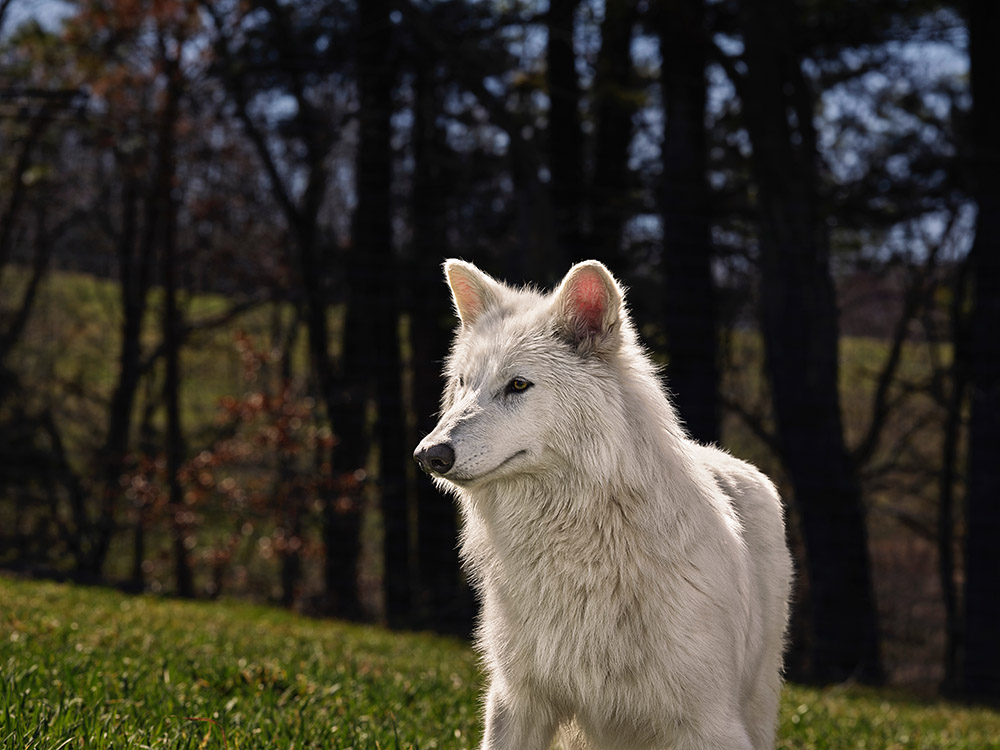The Dire Wolf’s Hollywood DNA

What do genetic engineering, Hollywood and animal conservation have in common? Look no further than the Colossal Biosciences company, which lit up the internet in early April with its claim that it had brought the dire wolf back from extinction — nearly 10,000 years after the massive prehistoric canine panted its last breath. While a debate has since raged over whether Colossal’s fluffy white beasts legitimately are dire wolves or whether they are simply gray wolves that have been genetically edited to approximate the real thing, one thing has been clear: Colossal, co-founded by tech entrepreneur Ben Lamm and Harvard geneticist George Church, pulled off a hell of a show — with Hollywood’s help.
To roll out the announcement of its purported dire wolf — an animal made famous on the hit show Game of Thrones — the company photographed two of the pups, Romulus and Remus, on the actual Iron Throne prop that HBO used to promote the series during its run. It was loaned to them by none other than Lord of the Rings director Peter Jackson, a Colossal investor and adviser, who bought the throne last year at auction. Colossal also enlisted Games of Thrones creator George R.R. Martin as an adviser and investor, later flying him out to meet the animals at their private compound set on around 2,000 acres in an undisclosed location. As part of its dire wolf announcement, the entertainment-minded company also played up the fact that the Grateful Dead had once recorded a song about the animal and that the lupine creatures also figure in the game Dungeons & Dragons.
Four-year-old Colossal — which has referred to itself as the De-Extinction Company — says that the dire wolves are just the first of a number of extinct animals that it plans to bring back from oblivion, including the woolly mammoth, the Tasmanian tiger and that ultimate symbol of species loss, the dodo. A slew of other entertainment world folks are also linked with Colossal. Film producer Thomas Tull, founder of Legendary Entertainment, has been a key investor, leading the company’s Series A funding round in 2022. Chris, Liam and Luke Hemsworth, Paris Hilton, Seth Green and Joe Manganiello are investors as well, while Candle Media’s Kevin Mayer and Paramount Pictures’ Mike Ireland serve on advisory boards for Colossal.
Jackson tells The Hollywood Reporter exclusively that he invested in the company because Colossal’s work has captivated his imagination. “As a kid I was so excited by the many scientific wonders that I assumed would happen before I reached the age of 25. The moon landings had just begun, so obviously we’d have flying cars by the time I got my driver’s license, not to mention personal submarines and jet packs,” says Jackson. “Six decades on, it’s fair to say that the world we live in is far from wondrous. So many dreams never came to pass. Then a couple of years ago, I became aware of Colossal Biosciences. Learning about the work this formidable group of clever people have been doing has rekindled my hope for the future. We’re on the eve of de-extinction stepping out of the realm of speculative science fiction, into an awe-inspiring new reality. I’m feeling like an excited kid again.”
In a recent interview with THR that took place before its big announcement, Lamm contended that the company had not sought out the majority of its Hollywood supporters, save for Martin, as well as Game of Thrones stars Kit Harington and Sophie Turner, who recently joined Colossal’s cultural advisory board. “It’s all happened organically,” says Lamm. “Like Joe [Manganiello] heard about us and reached out through a friend. The Hemsworths were early investors because they found out that we were working on the Tasmanian tiger and they’re like, ‘Can we invest and support the project?’ And then Peter Jackson heard about us.”

To promote its story and projects, Colossal is also working with two Hollywood directors, one an Oscar winner. Writer and director Michael Dougherty (Godzilla: King of the Monsters) took a role at Colossal in 2024 as an executive vp. Overseeing creative entertainment at the company, he’s rolled out a series of entertaining vintage high school biology class-style short films trumpeting Colossal’s latest advances, such as its March announcement that it had created a woolly mouse that had been genetically altered to express woolly mammoth-like traits such as shaggy fur and cold tolerance. As Dougherty puts it, “Colossal is the perfect fusion of art, science and magic.” The company has also signed up James Reed, co-director of the Oscar-winning documentary My Octopus Teacher, to make a documentary series about Colossal’s de-extinction projects.
A host of critics, however, contend that Colossal’s claim of bringing back an animal from extinction for the first time is more P.T. Barnum-style marketing than breakthrough science, with Vox, for instance, characterizing the company’s dire wolves as “closer to something like designer dogs.” It’s true that Colossal didn’t clone its wolves from actual dire wolf cells. Instead, it mapped the genome of the extinct wolf relying on DNA from a 13,000-year-old tooth and from a 72,000-year-old skull. It then made 20 edits to the genetic code of a gray wolf selecting for specific dire wolf characteristics, which it claims is a record number of edits successfully made at one time to produce a living organism. In a statement in response to the criticism that its wolves aren’t actually dire wolves, Colossal contends, among other things, that scientists don’t always agree on what the definition of a species is and that “our dire wolves look and act like dire wolves, so we believe it’s accurate to call them dire wolves.” The company added, “This is the most significant advancement in gene editing in history. Even our harshest critics admit it. As one of our founders stated, ‘This is the moon landing of synthetic biology.’”
Colossal, contends Lamm, isn’t just making dire wolves just for the Jurassic Park-like spectacle of it all. With every animal it brings back (or claims to bring back) from extinction, the company is also working to help ensure the survival of living species that are currently in danger of disappearing from the planet. As part of its dire wolf project, it also cloned two litters of red wolves, the most critically endangered wolves in the world, which, it says, will help expand the genetic diversity of the species.
Its effort to bring back the Tasmanian tiger, which went extinct in 1936, is being paired with a conservation project to help preserve an endangered marsupial called the northern quoll. “Thinking of Colossal as just a de-extinction company is failing to understand their full potential, for these same scientific breakthroughs will also be used to rescue multiple endangered species currently on the brink of extinction,” says Jackson. Critics, however, say that Colossal’s work could pull resources away from other conservation efforts. Responds Lamm, “It’s not a zero-sum game.” Regarding the company’s investors, he says, “This is all new money into conservation. We didn’t go to people that were [already] giving money to conservation.”

Despite the criticism that it has overstated its dire wolf claim, the company is forging ahead. To date, it has raised more than $435 million in venture capital funding. Last October, it announced that it had reconstructed 99.9 percent of the genome of the Tasmanian tiger. Lamm says that all of the technologies that it’s developing are open source, which “we give free to conservation.”
The work, of course, raises a host of ethical considerations, especially if someone uses that open-sourced technology in the future to, say, genetically engineer a Neanderthal. Lamm says that the company has clear lines in the sand. He says he’s frequently asked if Colossal would ever create mythical or fictional beings, including at SXSW a couple years ago when an eager interlocutor inquired about the possibility of making a living Pikachu. “Do I think that we at Colossal will have that technology and do I think that the world will eventually have technologies like that? Yes. Do I know if it serves a purpose? No. Right now, bringing back extinct species is hard enough.”
This story appears in the April 2025 Sustainability digital issue of The Hollywood Reporter magazine. Click here to see the rest of the issue.
Source: Hollywoodreporter
HiCelebNews online magazine publishes interesting content every day in the celebrity section of the entertainment category. Follow us to read the latest news.
Related Posts
- I Know What You Did Last Summer Trailer Teases Return of Jennifer Love Hewitt and Freddie Prinze Jr.
- Dianne Buswell shares candid comment on her ‘future’ with boyfriend Joe Sugg
- Shannon Sharpe Accused of Rape In Lawsuit
- Hi Felicia: Ice Cube Talks ‘Friday’ Return and Four Decades of Attitude
- ‘Awards Chatter’ Live Pod: Jason Isaacs on ‘The White Lotus,’ Lucius Malfoy and ‘The OA’





